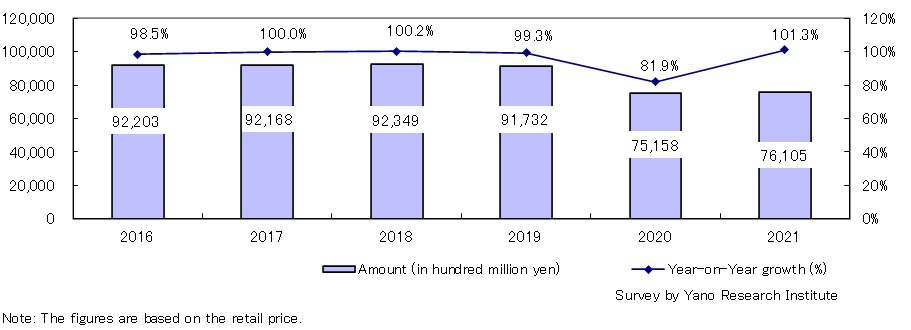No.3107
Apparel Market in Japan: Key Research Findings 2022
Apparel Retail Market Size for FY2021 Attains 101.3% Year-on-Year to 7,610,500 Million Yen
Yano Research Institute (the President, Takashi Mizukoshi) carried out a survey on the domestic apparel market and found out the market trends by item and by sales channel, as well as the current status of apparel industry including apparel manufacturers and retailers.

Market Overview
Size of the domestic apparel retail market as a total of men’s apparel, women’s apparel, and babies’/children’s apparel grew a modest to 7,610,500 million yen for FY2021, 101.3% of the previous fiscal year.
Viewing by sales channel, department stores and specialty stores are on recovery trend. While physical stores struggled to attract customers, the demand for e-commerce, which became widely adopted since 2019, showed steady growth in 2020, for it enables people to avoid outings in the COVID situation where stay-at-home was encouraged. As restrictions were softened in 2021, consumers started to go out again, and the sales at physical stores grew while e-commerce sales became sluggish conversely.
Noteworthy Topics
Trends of Apparel Industry in 2021
Overall, apparel industry has been accelerating the adoption of OMO (Online Merge Offline) strategy. Despite the expansion in sales and use of e-commerce, COVID-19 has impacted the market significantly, declining the market distribution volume to around 80% of that of pre-pandemic times. Against this backdrop, apparel companies have been focusing on e-commerce more than on marketing of physical stores that were more vulnerable to the COVID situation. Nonetheless, they are not completely into e-commerce. To avoid losing sales opportunities, apparel companies are trying to provide customer experience that integrates e-commerce with real stores.
Future Outlook
In the short term, the market expansion cannot be expected for 2022, because apparel companies continue to struggle in the COVID situation, while they do not increase expenses on marketing, such as advertising and sales promotion, unless their revenue level is recovered.
Apparel industry is facing predicaments in the long term, too, as they cannot expect stable market growth due to population decline.
Furthermore, external factors that affect consumers, such as pandemic restrictions which may be brought about by the emergence of new variants of COVID-19 and soaring prices of oil and other commodities due to the global situation, will not be favorable for the apparel retail market.
Meanwhile, there is a chance that price per item will rise. Driven by the increasing awareness of sustainability among consumers, sustainable products that apparel companies fervently produce are expected to grow its sales, even with relatively high prices. This is to say, the sales may decline by volumes, but rise by amount. However, even if price per item increases, it is unlikely yet to assume it can cover the decline of overall sales volume.
Research Outline
2.Research Object: Apparel manufacturers (manufacturers that produce two or more of the following product categories: men’s apparel, women’s apparel, babies’/children’s apparel, etc.,) retailers (department stores, mass merchandisers, specialty stores, and others), industry organizations, etc.
3.Research Methogology: Face-to-face interviews by our expert researchers (including online interviews), mailed questionnaire, and literature research
Apparel Market
The apparel market in this research indicates apparel manufacturers that produce two or more of the following product categories: men’s apparel, women’s apparel, and babies’/children’s apparel. The market size is calculated based on the retail price of apparel products. It does not include secondary market such as second-hand shops.
<Products and Services in the Market>
Men’s apparel (suits, jackets/blazers, coats, slacks, pants, shirts), women’s apparel (suits, formal wear, dresses, jackets/blazers, coats, bottoms, shirts/blouses), others (knit products [sweaters, T-shirts, polo shirts, etc.,], denim items, babies’/children’s items, underwear, etc.)
Published Report
Contact Us
The copyright and all other rights pertaining to this report belong to Yano Research Institute.
Please contact our PR team when quoting the report contents for the purpose other than media coverage.
Depending on the purpose of using our report, we may ask you to present your sentences for confirmation beforehand.